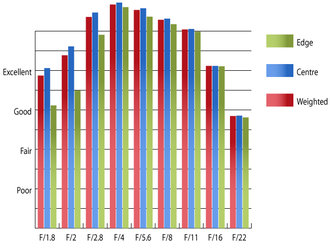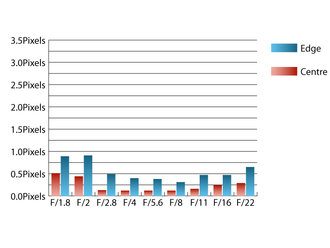Olympus M.Zuiko Digital 75mm f/1.8 Lens Review
Olympus M.Zuiko Digital 75mm f/1.8 Performance
As far as sharpness is concerned, this lens performs extremely well. Sharpness is already excellent in the centre of the frame at f/1.8 with good sharpness towards the edges of the frame at this aperture. Stopping down takes this lens into a league of its own. It is so sharp that you'll be hard pressed to see any difference in sharpness across the frame between f/2.8 and f/11. Resolution at 75mm | How to read our chartsThe blue column represents readings from the centre of the picture frame at the various apertures and the green is from the edges. Averaging them out gives the red weighted column.The scale on the left side is an indication of actual image resolution. The taller the column, the better the lens performance. Simple. For this review, the lens was tested on a Panasonic Lumix DMC-G3 using Imatest. |
Levels of chromatic aberrations may be a little on the high side for some people's taste at apertures faster than f/2.8. Fringing just exceeds 0.9 pixel widths towards the edges of the frame at these fast apertures. With the aperture stopped down to between f/2.8 and f/16 fringing remains below half a pixel width towards the edges of the frame, which should pose few issues.
 Chromatic aberration at 75mm | How to read our chartsChromatic aberration is the lens' inability to focus on the sensor or film all colours of visible light at the same point. Severe chromatic aberration gives a noticeable fringing or a halo effect around sharp edges within the picture. It can be cured in software.Apochromatic lenses have special lens elements aspheric, extra-low dispersion etc. to minimize the problem, hence they usually cost more. For this review, the lens was tested on a Panasonic Lumix DMC-G3 using Imatest. |
Falloff of illumination towards the corners of the frame is incredibly well controlled for a lens with such a fast maximum aperture. At f/1.8 the corners of the frame are only 0.8 stops darker than the image centre and illumination is visually uniform with the lens stopped down to f/2.8 or beyond.
Imatest was only able to detect 0.9% pincushion distortion during testing, which is a very low level indeed. If absolutely straight lines are paramount, you'll be glad to know that the distortion pattern is uniform across the frame, which should make applying correction in image editing software afterwards a breeze.
Olympus have applied their 'ZERO' anti-refection coating to this lens, and it is highly resistant to flare and loss of contrast as a result. However, it still would've been nice of Olympus to supply a hood with the lens as standard, even it if will rarely need it.

Portrait | 1/160 sec | f/11.0 | 75.0 mm | ISO 160
Add your message
Login required
Please login here or if you've not registered, you can register here. Registering is safe, quick and free.
Please login here or if you've not registered, you can register here. Registering is safe, quick and free.
photodo Stats
1102 lenses
428 MTF tests
74 in-depth photodo reviews
100+ users join each day
Help the lens community by reviewing or rating a lens today via our lens search
428 MTF tests
74 in-depth photodo reviews
100+ users join each day
Help the lens community by reviewing or rating a lens today via our lens search
Latest Lens Reviews
- Chinon 28mm f/2.8 Vintage Lens Review
- Canon EF 70-200mm f/4L IS II USM Lens Review
- Samyang AF 85mm f/1.4 EF Review
- Sigma 70mm f/2.8 DG Macro Art Review
- Samyang AF 24mm f/2.8 FE Review
- Meike 50mm f/1.7 Review
- Tamron 70-210mm f/4 Di VC USD Review
- Lensbaby Burnside 35mm f/2.8 Review
- Asahi Super Takumar 50mm f/1.4 Review
- Asahi Super-Multi-Coated Takumar 135mm f/3.5 Review
